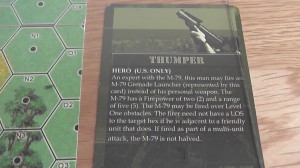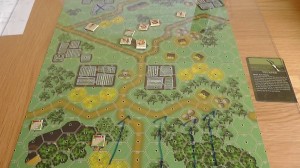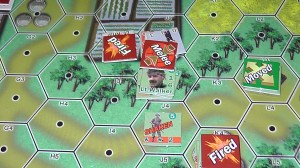The US in Vietnam
After my foray into French Indochina in the fifties, I am now jumping ahead a decade or so to the Vietnam War fought by the Americans and their allies.
After the exit of the French following the devastating defeat at Dien Bien Phu, Vietnam was temporarily separated at the 17th parallel and two separate states were established. The plan was to have a unified country and elections for all citizens a year later. During this time, hundreds of thousands of Vietnamese moved between North and South, more than a million Catholics leaving the communist North. The election was won by the Southern Catholic and US-American backed leader Diem. It was evident that the elections were rigged and the Viet Cong began insurgencies around the country which, eventually, led to deployment of US troops to stabilize the situation, especially after the ousting of Diem. The result of this was one of the biggest defeats the US army had ever encountered. The war was protracted for a decade and more and the US finally exited the country in 1973-1975.
Lock ‘n Load – Forgotten Heroes Vietnam
 The first game I am playing related to the American war effort in Vietnam is Lock ‘n Load’s Forgotten Heroes Vietnam. It is a squad-level tactical game and all observations below are based on the first edition published by Shrapnel Games, designed by Mark H. Walker and published in 2003.
The first game I am playing related to the American war effort in Vietnam is Lock ‘n Load’s Forgotten Heroes Vietnam. It is a squad-level tactical game and all observations below are based on the first edition published by Shrapnel Games, designed by Mark H. Walker and published in 2003.
First look at the contents and basic concepts
The game is played on geomorphic maps which can be freely put together at the edges to form new terrain (the maps are glossy paper, very much like the maps from the ASL Starter Kits). The terrain is very detailed and consists of open grass land, jungle, rice paddies, tall grass, hills, different types of buildings etc. Each hex represents around 50 metres. The counters represent squads (Multi-man counters), Leaders, heroes, chaplains, advisors, snipers (Single-man counters) and weapons as well as vehicles and choppers.
In addition, the game comes with several dozens of information counters for statuses such as “Moved”; “Fired”; “Ops completed”. Line of Sight plays an important role and its determination needs to be taken seriously in order to not spoil the fun and make the game too easy. (For people not used to this granular level, it may be easier to get over this obstacle by imagining the map to be three-dimensional: While looking down on the map you can see everything and know where everyone is, you need to put yourself in the shoes of the squads in the map, their line of sight is blocked or degraded by the surrounding terrain and so they “don’t know and can’t see” where everyone else is. This takes some getting used to and some level of meta-gaming will probably always prevail).
In order for the “guys in the map” to “see” other units, they need a traceable line of sight to their target’s hex and need to spot them. Unless the target-hex is clear terrain, whoever is in there is not automatically visible (imagine someone standing in the bushes outside your house, unless they move, or unless they wear a hi-viz jacket, you will probably not make them out easily without peering at them intently and maybe getting the old binoculars out). Consequently, you either need to “spot” the target actively through rolling 1d6 with DRMs (getting out your binoculars), or your target makes itself known by moving, shooting or any other action that qualifies as “autospotting”.
In addition to maps and counters, the game comes with a number of skill cards, which can be added to certain counters (mainly heroes and leaders) and which provide certain benefits, either temporary or permanent, to the Single-man counter they are associated with.

Last but not least, the game comes with more than a dozen scenario cards. These cards describe the set-up, the victory conditions and any other information you need to know.
A brief look at the rules
Yes, rules are quite often a bone of contention with me. Comes with the job. These rules are old, they have been superseded by version 3 at this stage. And seeing as they are the first version, there are some unclarities in it (Melee is described a bit weirdly, and Line of Sight could have benefited from more details and pictures, and the rules about Ordnance Weapons Teams seem simply wrong when I compare them to what I see on the counters) However, if you use your common sense and just make certain rulings yourself, you will be totally fine playing the game with the basic rules that come with the first edition (unlike the rules for “Citadel” mentioned elsewhere). What I do like very much about the rules is that they are a bit modular. Every so often, you will get to a paragraph that reads “Stop! Or at least pause, you are now ready to play scenario XYZ”.
The system is built up so userfriendly that it guides you through the rules by giving you modules which you can play after you have digested certain parts of the rules. This pedagogical approach is very good and it makes it possible even for people who have never played a wargame to get into it really quickly. One could say you go from basic training to deployment in-country as you go through the rules (which only have around 20 or so pages).
Mechanics and Narrative
The game is impulse-based and plays over a preset number of turns. If the objectives are not met within the given turn-frame, the player(s) lose; alternatively, the player with the most victory points wins. Unlike other games, the impulse is generally either movement or firing/fighting (games from the GBoH series or MoI, but also PGG have a move-and-fire/fight impulse). Only a select few units can move and fight in the same impulse (and hence on the same turn), this is called “assault movement”. Players take alternating impulses until there are three passes in a row or all units have been activated.
Battles are resolved using odds-based tables for Melee and terrain-based /fire-power-based morale checks for direct fire. These checks happen frequently, but are resolved very quickly by rolling 1 or 2 d6 (much less effort than in SGBoH, much fewer stats to remember and take into consideration). Results and statuses are marked by flipping counters and/or placing information markers.
The game plays very quickly (I have only played 3 scenarios, one of them twice, and I can say that it plays very quickly, the rules become internalized very easily). The stories that are told in the scenarios are gripping and tense and I felt I was really there (a feeling I also experienced in the battles of Caesar Conquest of Gaul, also a tactical game, but “zoomed out”). There was not a single time when I felt that decisions were unnatural, ambiguous or “gamey”. Another thing that I have experienced recently (also in Tonkin) is that sometimes, the best decision is not to do anything but to wait. Something that is not so prevalent in Ancients, as there the objective is to win the battle, and so you will always advance. Here, however, it is quite often a good idea to wait because you just don’t know where the enemy is, and you might move right into their line of sight and get yourself killed. At the same time, the turn track forces the players’ hands, because by simply waiting, the US will usually lose by default.

This game and its system should appeal to wargamers as well as non-wargamers and could be used as a gateway game into the wargaming hobby. It plays fast, has a number of different themes (Vietnam, Blitzkrieg, South Pacific, East Front) and is easy to learn. At the same time, it does provide enough depth and realism to keep discerning grognards happy and fills a niche for those of us who cannot afford the time (and perhaps the money) to get stuck into ASL, which this series is definitely indebted to.
I will continue with this game for a little while longer before moving to my next South-East-Asian-themed game and have already pre-ordered Anzac Attack, Heroes of the Pacific, and have recently bought Heroes of the Blitzkrieg. I like the system and find it enjoyable. Enough depth without too much set-up and no chrome! My kind of recreational wargame.

Your a idiot. We didnt lose Vietnam, the South Vietnamese lost. You damn commie. 22/4 tears after we left and had agreement with Commie’s like you, changing history. We had hostilities ended and just like Muslims,commies,liberals you blather like a fool. FYI cease fire Jan. 31,1973 and last ground troops pulled out end of March. Vietnam fell after years of training and arming and fighting for them. FELL IN MAY IF 75 DUMBAZZ.
you can watch your tone. This is a guest post first of all. You can define your reality how you wish and parse the facts as you see fit. Indeed the US did leave earlier than written. I’m the only person that gets to talk like that. I’m not a dumbazz, or a commie and I have plenty of Vietnam Vets who would disagree with you that said. Next comment I see better be polite, or I’ll block you from the site and delete your comments. Be respectful and state your case. Otherwise…fuck off.
See I get to say what I like. Cute aint it.